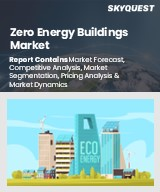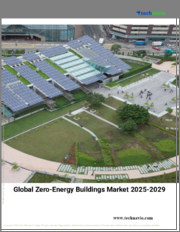
|
시장보고서
상품코드
1838283
제로 에너지 빌딩 시장 규모, 점유율, 성장 분석 : 구성 요소별, 용도별, 지역별 예측(2025-2032년)Zero Energy Buildings Market Size, Share, and Growth Analysis, By Component (HVAC System, Lighting), By Application (Residential, Non-residential), By Region - Industry Forecast 2025-2032 |
||||||
세계의 제로 에너지 빌딩 시장 규모는 2023년 32억 달러로 평가되었고, 예측 기간(2025-2032년)의 CAGR은 25.2%를 나타내, 2024년 40억 1,000만 달러에서 2032년에는 241억 9,000만 달러로 성장할 것으로 예상되고 있습니다.
세계의 제로 에너지 빌딩 시장은 환경 지속가능성에 대한 관심 증가, 도시화, 바이오필릭 디자인의 채용 등에 의해 큰 성장이 전망되고 있습니다. 소비자와 건설 회사의 환경 의식이 높아짐에 따라 도시의 더위를 완화하고 공기의 질을 개선하고 생물 다양성을 높이는 솔루션에 대한 수요가 높아지고 제로 에너지 빌딩은 높은 주목을 받고 있습니다. 도시의 확대에 의해 수평 방향의 녹지가 제한되는 가운데, 제로 에너지 원칙을 도입한 수직 방향의 설계가 불가결해지고 있습니다. 스마트 센서와 자동 관개와 같은 그린월 기술의 혁신은 그 기능성과 매력을 높이고 있습니다. 게다가 고급 주택과 접객에 대한 수요 증가는 제로 에너지 빌딩의 미학과 일치하고 있습니다. 그러나 초기 비용 상승, 숙련 노동자 부족, 기후 적응성 우려와 같은 문제는 시장 침투를 방해할 수 있습니다.
목차
서론
- 조사의 목적
- 조사 범위
- 정의
조사 방법
- 정보 조달
- 2차와 1차 데이터의 방법
- 시장 규모 예측
- 시장의 전제조건과 제한
주요 요약
- 세계 시장 전망
- 공급과 수요 동향 분석
- 부문별 기회 분석
시장 역학과 전망
- 시장 개요
- 시장 규모
- 시장 역학
- 성장 촉진요인과 기회
- 성장 억제요인과 과제
- Porter's Five Forces 분석
주요 시장 인사이트
- 성공 핵심 요소
- 경쟁 정도
- 주요 투자 분야
- 시장 생태계
- 시장 매력 지수(2024년)
- PESTEL 분석
- 거시경제지표
- 밸류체인 분석
- 가격 분석
제로 에너지 빌딩 시장 규모 : 구성 요소별&CAGR(2025-2032년)
- 시장 개요
- HVAC 시스템
- 조명
- 벽 및 지붕
- 기타
제로 에너지 빌딩 시장 규모 : 용도별&CAGR(2025-2032년)
- 시장 개요
- 주택용
- 비주택용
제로 에너지 빌딩 시장 규모 : 지역별&CAGR(2025-2032년)
- 북미
- 미국
- 캐나다
- 유럽
- 독일
- 스페인
- 프랑스
- 영국
- 이탈리아
- 기타 유럽
- 아시아태평양
- 중국
- 인도
- 일본
- 한국
- 기타 아시아태평양
- 라틴아메리카
- 브라질
- 기타 라틴아메리카
- 중동 및 아프리카
- GCC 국가
- 남아프리카
- 기타 중동 및 아프리카
경쟁 정보
- 상위 5개사 비교
- 주요 기업 시장 포지셔닝(2024년)
- 주요 시장 기업이 채용한 전략
- 최근 시장 동향
- 기업 시장 점유율 분석(2024년)
- 주요 기업 프로파일
- 기업 상세 정보
- 제품 포트폴리오 분석
- 기업 부문별 점유율 분석
- 연간 매출 비교(2022-2024년)
주요 기업 프로파일
- Serie Architects(UK)
- Skidmore, Owings& Merrill(SOM)(USA)
- Foster Partners(UK)
- Miller Hull(USA)
- Morphosis(USA)
- Bere : Architects(UK)
- Integral Group(USA)
- CannonDesign(USA)
- DPR Construction(USA)
- 스칸스카(스웨덴)
- Lendlease(Australia)
- Turner Construction(USA)
- AECOM(USA)
- Honeywell International(USA)
- Johnson Controls(USA)
- Schneider Electric(France)
- Panasonic Corporation(Japan)
- Siemens AG(Germany)
- Mahindra Lifespace Developers(India)
- Rockwool Group(Denmark)
결론과 권고
KTH 25.10.22Global Zero Energy Buildings Market size was valued at USD 3.2 billion in 2023 and is poised to grow from USD 4.01 billion in 2024 to USD 24.19 billion by 2032, growing at a CAGR of 25.2% during the forecast period (2025-2032).
The global market for zero energy buildings is poised for significant growth due to increasing focus on environmental sustainability, urbanization, and the adoption of biophilic design. Growing environmental consciousness among consumers and construction firms has heightened the demand for solutions that mitigate urban heat, improve air quality, and boost biodiversity, making zero energy buildings highly sought after. As urban expansion limits horizontal green space, vertical designs incorporating zero energy principles are becoming essential. Innovations in green wall technology, such as smart sensors and automated irrigation, enhance their functionality and appeal. Additionally, the rising demand for luxury housing and hospitality aligns with the aesthetics of zero energy buildings. However, challenges like high initial costs, skilled labor shortages, and concerns about climate adaptability may hinder market penetration.
Top-down and bottom-up approaches were used to estimate and validate the size of the Global Zero Energy Buildings market and to estimate the size of various other dependent submarkets. The research methodology used to estimate the market size includes the following details: The key players in the market were identified through secondary research, and their market shares in the respective regions were determined through primary and secondary research. This entire procedure includes the study of the annual and financial reports of the top market players and extensive interviews for key insights from industry leaders such as CEOs, VPs, directors, and marketing executives. All percentage shares split, and breakdowns were determined using secondary sources and verified through Primary sources. All possible parameters that affect the markets covered in this research study have been accounted for, viewed in extensive detail, verified through primary research, and analyzed to get the final quantitative and qualitative data.
Global Zero Energy Buildings Market Segments Analysis
Global Zero Energy Buildings Market is segmented by Component, Application and region. Based on Component, the market is segmented into HVAC System, Lighting, Walls & Roofs and Others. Based on Application, the market is segmented into Residential and Non-residential. Based on region, the market is segmented into North America, Europe, Asia Pacific, Latin America and Middle East & Africa.
Driver of the Global Zero Energy Buildings Market
The global market for zero energy buildings is being significantly driven by a strong focus on sustainability, alongside the decreasing costs associated with the integration of renewable energy sources. The ability of buildings to generate renewable energy onsite allows them to balance energy consumption and achieve net-zero objectives effectively. Additionally, incorporating battery storage systems improves the resilience of these buildings, ensuring reliable power during periods of high demand or outages. Consequently, innovations in renewable energy technologies are playing a crucial role in fostering the growth and appeal of zero energy buildings in the construction sector.
Restraints in the Global Zero Energy Buildings Market
The adoption of zero energy buildings is significantly influenced by various factors such as infrastructure preparedness, environmental conditions, and the presence of regulatory support, which can vary greatly across different regions. In areas where power grids are unstable or where the costs associated with renewable energy technologies are prohibitive, the practicality and economic advantages of implementing zero energy buildings diminish. Additionally, inconsistent international policies and differing regulatory environments hinder the growth and demand for such sustainable constructions, creating a challenging landscape for broader acceptance. These disparities collectively act as obstacles to the widespread implementation of zero energy buildings globally.
Market Trends of the Global Zero Energy Buildings Market
The Global Zero Energy Buildings market is witnessing significant momentum driven by the increasing adoption of net-zero policies and standards. Governments and regulatory bodies are implementing initiatives that mandate or promote sustainable building practices, creating a favorable environment for growth. This shift is further accelerated by legislation like enhanced energy performance directives and regional net-zero codes. As stakeholders recognize the environmental and economic benefits of energy-efficient designs, the market is expected to expand. The focus on sustainability is likely to solidify the commitment to zero energy buildings, paving the way for innovative solutions and technologies that meet these evolving standards.
Table of Contents
Introduction
- Objectives of the Study
- Scope of the Report
- Definitions
Research Methodology
- Information Procurement
- Secondary & Primary Data Methods
- Market Size Estimation
- Market Assumptions & Limitations
Executive Summary
- Global Market Outlook
- Supply & Demand Trend Analysis
- Segmental Opportunity Analysis
Market Dynamics & Outlook
- Market Overview
- Market Size
- Market Dynamics
- Drivers & Opportunities
- Restraints & Challenges
- Porters Analysis
- Competitive rivalry
- Threat of substitute
- Bargaining power of buyers
- Threat of new entrants
- Bargaining power of suppliers
Key Market Insights
- Key Success Factors
- Degree of Competition
- Top Investment Pockets
- Market Ecosystem
- Market Attractiveness Index, 2024
- PESTEL Analysis
- Macro-Economic Indicators
- Value Chain Analysis
- Pricing Analysis
Global Zero Energy Buildings Market Size by Component & CAGR (2025-2032)
- Market Overview
- HVAC System
- Lighting
- Walls & Roofs
- Others
Global Zero Energy Buildings Market Size by Application & CAGR (2025-2032)
- Market Overview
- Residential
- Non-residential
Global Zero Energy Buildings Market Size & CAGR (2025-2032)
- North America (Component, Application)
- US
- Canada
- Europe (Component, Application)
- Germany
- Spain
- France
- UK
- Italy
- Rest of Europe
- Asia Pacific (Component, Application)
- China
- India
- Japan
- South Korea
- Rest of Asia-Pacific
- Latin America (Component, Application)
- Brazil
- Rest of Latin America
- Middle East & Africa (Component, Application)
- GCC Countries
- South Africa
- Rest of Middle East & Africa
Competitive Intelligence
- Top 5 Player Comparison
- Market Positioning of Key Players, 2024
- Strategies Adopted by Key Market Players
- Recent Developments in the Market
- Company Market Share Analysis, 2024
- Company Profiles of All Key Players
- Company Details
- Product Portfolio Analysis
- Company's Segmental Share Analysis
- Revenue Y-O-Y Comparison (2022-2024)
Key Company Profiles
- Serie Architects (UK)
- Company Overview
- Business Segment Overview
- Financial Updates
- Key Developments
- Skidmore, Owings & Merrill (SOM) (USA)
- Company Overview
- Business Segment Overview
- Financial Updates
- Key Developments
- Foster + Partners (UK)
- Company Overview
- Business Segment Overview
- Financial Updates
- Key Developments
- Miller Hull (USA)
- Company Overview
- Business Segment Overview
- Financial Updates
- Key Developments
- Morphosis (USA)
- Company Overview
- Business Segment Overview
- Financial Updates
- Key Developments
- Bere: Architects (UK)
- Company Overview
- Business Segment Overview
- Financial Updates
- Key Developments
- Integral Group (USA)
- Company Overview
- Business Segment Overview
- Financial Updates
- Key Developments
- CannonDesign (USA)
- Company Overview
- Business Segment Overview
- Financial Updates
- Key Developments
- DPR Construction (USA)
- Company Overview
- Business Segment Overview
- Financial Updates
- Key Developments
- Skanska (Sweden)
- Company Overview
- Business Segment Overview
- Financial Updates
- Key Developments
- Lendlease (Australia)
- Company Overview
- Business Segment Overview
- Financial Updates
- Key Developments
- Turner Construction (USA)
- Company Overview
- Business Segment Overview
- Financial Updates
- Key Developments
- AECOM (USA)
- Company Overview
- Business Segment Overview
- Financial Updates
- Key Developments
- Honeywell International (USA)
- Company Overview
- Business Segment Overview
- Financial Updates
- Key Developments
- Johnson Controls (USA)
- Company Overview
- Business Segment Overview
- Financial Updates
- Key Developments
- Schneider Electric (France)
- Company Overview
- Business Segment Overview
- Financial Updates
- Key Developments
- Panasonic Corporation (Japan)
- Company Overview
- Business Segment Overview
- Financial Updates
- Key Developments
- Siemens AG (Germany)
- Company Overview
- Business Segment Overview
- Financial Updates
- Key Developments
- Mahindra Lifespace Developers (India)
- Company Overview
- Business Segment Overview
- Financial Updates
- Key Developments
- Rockwool Group (Denmark)
- Company Overview
- Business Segment Overview
- Financial Updates
- Key Developments












